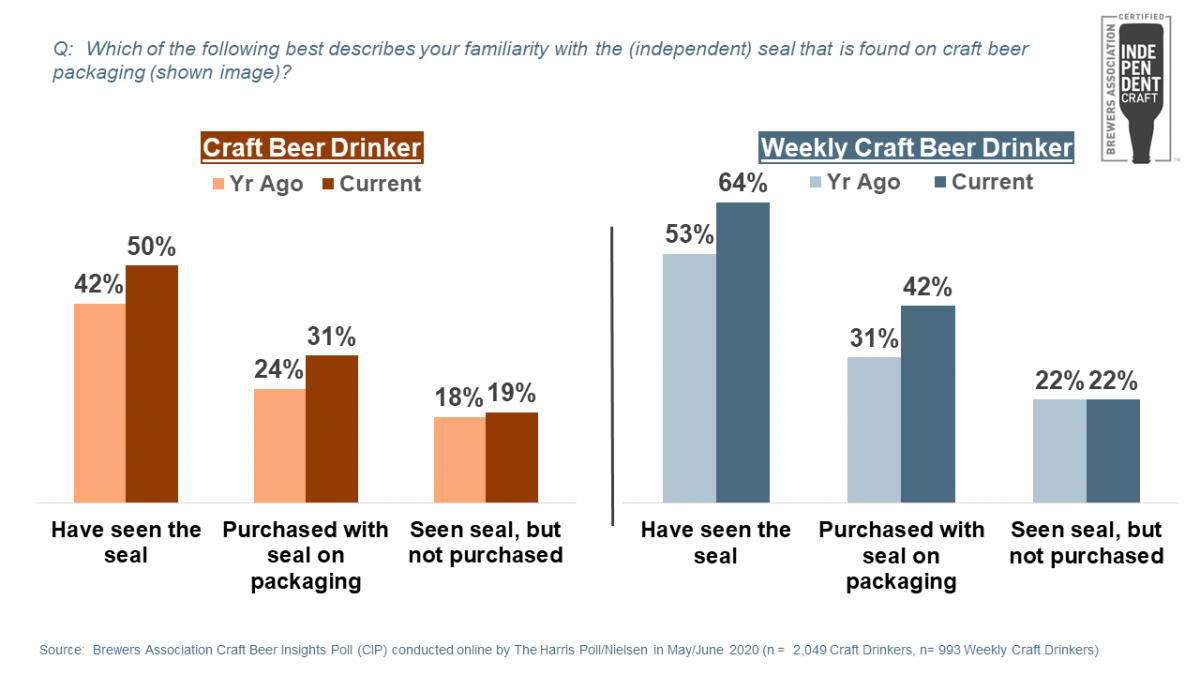The independent craft brewer seal was designed as a visual representation of the craft brewer definition as well as to close a gap. We knew from consumer surveys that “made by an independent brewer” was important to many craft drinkers. In our latest Nielsen-Harris data, 72% of weekly craft beer drinkers say they factored that into their purchase decision. At the same time, we’ve also seen consistent evidence that the average consumer doesn’t really know who is independent and who isn’t. This makes sense. With thousands of brewers, it isn’t every consumer’s job to keep up with who bought who. Unlike local, where you have a brewery to visit, there isn’t any physical manifestation to tell you about who made the new IPA that showed up in your local bottle shop.
The seal is designed as an easy visual reference point for those who care. As an added benefit, it’s also an easy way to communicate to others who might be buying beer for the household that you care. In the same way you might tell your spouse to make sure the strawberries are organic (my wife does this every week when I go shopping), you can tell the shopper to look for the seal when picking up the fresh hop beers hitting stores in the next few weeks.
Thousands of brewers have invested in this shared mark, and their collective efforts are starting to show results in terms of awareness and perhaps even purchase decisions (much harder to measure).
First, in our annual Nielsen data, we asked, “Which of the following best describes your familiarity with the (independent) seal that is found on craft beer packaging?” while showing them a picture of the seal on generic packaging. 50% of craft consumers (those who responded that they drink craft “at least several times a year”) said they had seen the seal, up from 42% last year, and 64% of weekly craft drinkers said they had seen it, up from 53% last year. Even better, 31% of craft drinkers and 42% of weekly craft drinkers said they had purchased beer with the seal on the packaging (up from 24% and 31% respectively).
Seal Awareness and Purchase Conversion, 2019 versus 2020

We’ve also tracked a similar question around purchase likelihood through a large survey of on-premise consumers conducted by Nielsen CGA. In this survey, consumers were asked, “If you saw this logo on beer, how much, if at all, would it affect your likelihood of purchasing the beer?” In the latest results (Spring 2020), 49% said it would make them more likely (14% much more, 35% slightly more), 8% less (2% much less, 5% slightly less; numbers don’t add due to rounding), and 43% said it wouldn’t affect their decision at all. That net +41% between more and less likely is the highest over 5 iterations of this survey, and almost double from the first time we fielded in fall 2017.
Change in Net Purchase Likelihood Fall 2017-Spring 2020
While one survey result should always be taken with caution, the large sample size on this survey (n = 3,855, so the margin of error is a bit below 2%) and the jump in the separate Nielsen-Harris survey give some confidence that awareness and purchase intent around the seal are indeed moving in the direction that small brewers would want to see.
In the end, none of this matters if it isn’t actually driving purchases. 100% of people could say they care about independence, but if that doesn’t translate to what they pick on tap or off the shelf, it doesn’t really matter. Lots of people say they are going to eat better and get in shape every year. Some do, plenty don’t.
The current data don’t show a huge gap. Nielsen data (Nielsen AOD, W.E. 6.13.20) over the past 52 weeks in scan shows independent craft growing 5.0% in dollar sales versus 4.8% for all craft (suggesting non-independent craft is slightly lower). That said, we can’t run the counterfactual for what those numbers look like without the seal. The advantages held by the large brewers in scale, influence with distribution and retail, and resources toward marketing likely build in some natural advantages that would show up in scan. So it’s possible that independent craft growing slightly faster than other fuller-flavored brands actually represents a larger bump from the seal.
While in an ideal world we’d see a bigger gap in trends, the seal is only going to be one part of that, with almost every consumer considering a larger set of purchase factors including style, brand, price, availability, and more. Increasing awareness of the seal and acknowledgement of purchase are just one more factor that hopefully helps small brewer brands win the next jump ball when a consumer is deciding between several choices.





 Resource Hub
Resource Hub